Commitment to TCFD Recommendations
In January 2020, SPARX Group ("the Group) announced its agreement with the recommendations published by the Task Force on Climate-Related Financial Disclosures (TCFD) as part of its active involvement in realizing, through investment, a society in which human beings can coexist with the global environment.
The following is a report on the status of our efforts to meet the TCFD recommendations for FY2022 ended March 31, 2023 per its recommended disclosure categories of Governance, Strategy, Risk Management, and Metrics and Targets related to climate change-related risks and opportunities. We will continue to advance initiatives addressing climate change issues and disclose related information.
Governance
The Group has formulated a Basic Sustainability Policy based on its recognition that addressing climate change and other sustainability-related issues is one of the most crucial aspects of management. Thus we have built a governance structure based on the Board of Directors and a Management Meeting. The Board of Directors debates and decides on the climate change issues related to this basic policy and supervises the Management Meeting, the central decision-making body for day-to-day corporate operations. The Management Meeting discusses and decides on specific sustainability policies and promotion strategies at least annually and when otherwise necessary and reports its activities to the Board.
The Board of Directors, consisting mostly of outside directors, also verifies and discusses the progress of these specific policies and promotion strategies to ensure appropriate management and continuous improvement through the PDCA cycle. The Management Meeting, which includes all full-time directors and executive officers at the core of corporate operations, meets at least once a month and promptly reports its activities to the Board of Directors. We have also established a Sustainability Planning department to facilitate specific discussions on sustainability management at the Management Meeting.
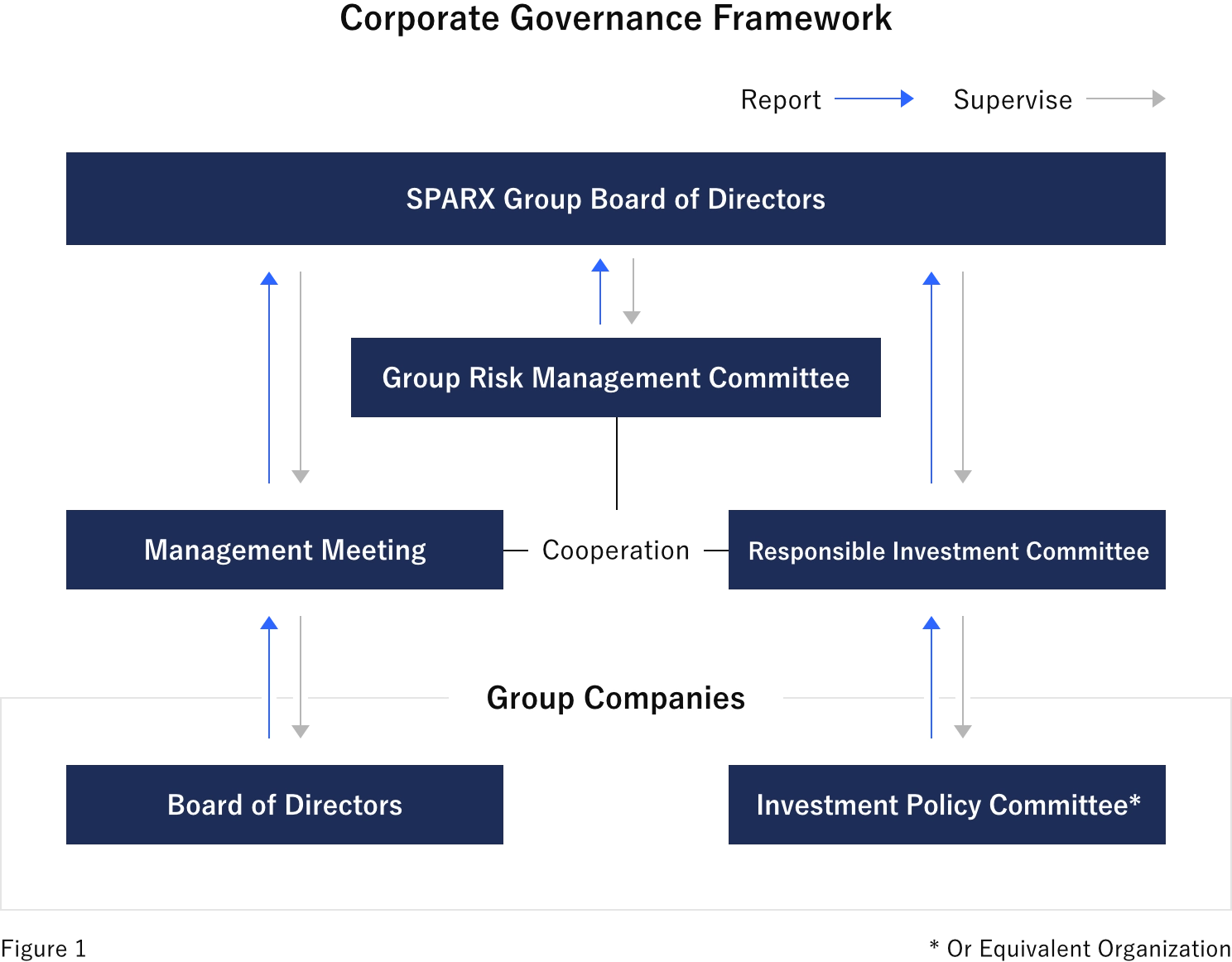
Strategy
The Group recognizes that maintaining a sustainable global ecosystem and environment is essential for the medium- to long-term management of client assets. In particular, the Group sees climate change issues as vital in achieving this objective.
Climate change presents associated risks and opportunities due to the severe natural disasters caused by rising average temperatures and the socioeconomic changes brought about by the shift to a carbon-free society.
There are two types of risks: physical risks can be acute--caused by increases in natural disasters and extreme weather events--or chronic--stemming from rising average temperatures; and transition risks result from stricter regulations meant to eliminate society's carbon dependence and responses to adopting decarbonization technology.
The opportunities include potential corporate revenue from technological innovations and market changes addressing climate change problems. The Group supports and promotes solutions addressing climate change and the transition to a carbon-free society by providing new investment products, leading to more business opportunities and helping achieve a sustainable environment and society.
Based on the TCFD's recommendations, the Group is working, as shown below, to understand the opportunities, physical risks, and transition risks from short-, medium-, and long-term perspectives. The direct impact of climate change on the Group as an investment company should be less significant than in other industries. However, we will examine these assumptions by analyzing multiple scenarios to understand more specific financial and other effects. To prepare for physical risks from large-scale natural disasters, the Group regularly reviews its BCP and bolsters its management systems to maintain business continuity.
Climate-Related Risks
- [Expected periods] Short term: 0-3 years, medium term: 3-10 years, long term: 10-30 years
Opportunities from Climate Change
When considering measures to address the above climate-related risks, we can redefine them as business opportunities and tie them to ideas for investment strategies. For instance, the risk of a "delayed response to changes in industrial structure due to rapid technological innovation" would become "finding investment opportunities in companies that possess technologies that will bring about rapid changes in the industrial structure and incorporating them into investment strategies."
Risk Management
The Group has instituted its Basic Group Risk Management Rules to establish an essential risk management framework, identifying in advance expected individual risks and managing them appropriately. As a result, we address the Group's risks and ensure its soundness and integrity.
Moreover, the Board of Directors has established a Group Risk Management Committee to review and deliberate on corporate and Group risk management matters. The Group Risk Management Committee includes all full-time directors and executive officers at the core of corporate operations and meets once a quarter as a general rule. The Group Risk Management Committee follows the risk management process stipulated in the Basic Group Risk Management Rules to identify potential expected risks and emergent material phenomena, recognize and assess risks, develop and implement countermeasures, and monitor how these countermeasures work.
The Group Risk Management Committee also reports its minutes to the Board of Directors in a timely manner. The Board of Directors, consisting mostly of outside directors, monitors risk locations, types, countermeasures, and their implementation and supervises the risk management process. In this role, the Board establishes and continuously improves an appropriate risk management approach for the Group's management circumstances and strategies.
Currently, the Group manages climate-related risks not as a risk category set and governed under the Basic Rules on Group Risk Management but as a factor with a potential general impact on all risk categories. We will continue improving and strengthening our risk management approach to climate change issues.
Metrics and Targets
The Group aims to achieve carbon neutrality by 2050, promotes decarbonization initiatives, and monitors its established indicators and targets to reduce climate-related risks and realize opportunities. All Group companies report their progress in these indicators to the Management Meeting and the Board of Directors annually or as otherwise required.
Of the greenhouse gas ("GHG") emissions generated by the Group's business activities in FY2022, the total of Scope 1 and Scope 2*1 was approximately 109.67 tCO2e, a 22.7% decrease from FY2020. In September 2022, as part of our efforts to reduce GHG emissions, we switched to contracts for electricity derived from renewable energy sources using non-fossil certificates for use in buildings for six Japanese Group companies. We will strive to further reduce GHG emissions to achieve our interim target of a 33% reduction by FY2030 (compared to FY2020) ahead of schedule.
The actual figures for GHG emissions established as indicators are shown below. In addition to managing progress toward our GHG emissions reduction targets (Scope 1 and Scope 2), we have begun calculating and monitoring CO2 emissions in our supply chain (Scope 3) using the Ministry of the Environment's Green Value Chain Platform and other tools. We also recognize that our calculation in Category 15: Investments and Loans to boost our Scope 3 disclosure is the first step as a financial institution toward helping realize a carbon-free society. We will continue to measure GHG emissions through investments and loans (Financed Emissions) based on the PCAF*2 methodology.
Scope1・2 tCO2e
| FY2020 | FY2021 | FY2022 | |
|---|---|---|---|
| Scope1 (direct emission) | 6.05 | 6.13 | 6.13 |
| Scope2 (indirect emission)*3 | 135.93 | 126.64 | 103.67 |
| Scope1・Scope2 Total | 141.98 | 132.77 | 109.80 |
| Reduction Results (Compared to FY2020) | - | 6.5% | 22.7% |
| Reduction Results (Compared to previous year) | - | 6.5% | 17.3% |
Scope3 tCO2e
| Category | FY2021 | FY2022 | |
|---|---|---|---|
| Scope3 | Category1 (Purchased Goods and Services) |
3.09 | 2.81 |
| Scope3 | Category2 (Capital Goods) | 9.81 | 249.23 |
| Scope3 | Category5 (Waste Generated in Operations) |
0.28 | 0.39 |
| Scope3 | Category6 (Business Travel) | 136.52 | 576.47 |
| Scope3 | Category7 (Employee Commuting) | 62.93 | 51.70 |
[Calculation period]
Each period : from April 1st to March 31 in the following year
[Calculation scope]
Scope1・Scope2:6 Tokyo-based Group companies*4, SPARX Asset Management Korea Co., Ltd. *5, SPARX Asia Investment Advisors Limited*5
Scope3:6 Tokyo-based group companies*4
[Calculation Methods]
Our Scope 3 calculation method and emission figures are based on the "Basic Guidelines on Accounting for Greenhouse Gas Emissions Throughout the Supply Chain Ver. 2.5" and "Emission Unit Value Database for Accounting of Greenhouse Gas Emissions by Organizations Throughout the Supply Chain Ver 3.3" from the Ministry of the Environment and the Ministry of Economy, Trade and Industry.
Category 1: Calculated by multiplying the cost of copy paper purchased by the six Tokyo-based Group companies by the emission unit values
Category 2: Calculated by multiplying the value of fixed assets acquired by the six Tokyo-based Group companies in the relevant fiscal year by the emission unit values
Category 5: Calculated by multiplying the waste generated by the six Tokyo-based Group companies by the emission unit values by waste type and disposal method
Category 6: Calculated based on the amount of domestic and international business travel by the six Tokyo-based Group companies (multiplied the cost for using airlines, rail, buses, and taxis by the emission unit values)
Category 7: Calculated from the yearly total of the monthly commuting expenses of employees of the six Tokyo-based Group companies at the end of the current fiscal year (multiplied the cost of using rail and buses by the emission unit values)
- *1 GHG emissions calculation criteria are Scope 1 (direct emissions) + Scope 2 (indirect emissions) based on the GHG Protocol.
- *2 Partnership for Carbon Accounting Financials
- *3 Scope 2 is the results of the market-based method.
- *4 Six Tokyo-based Group companies are as below:
SPARX Group Co., Ltd.
SPARX Asset Management Co., Ltd.
SPARX Green Energy & Technology Co., Ltd.
SPARX Asset Trust & Management Co., Ltd.
SPARX AI & Technologies Investment Co., Ltd.
SPARX Innovation for Future Co., Ltd. - *5 We use the emissions coefficients for each country where the offices are located.
Reduction of CO2 Emissions from SPARX's Business Activities
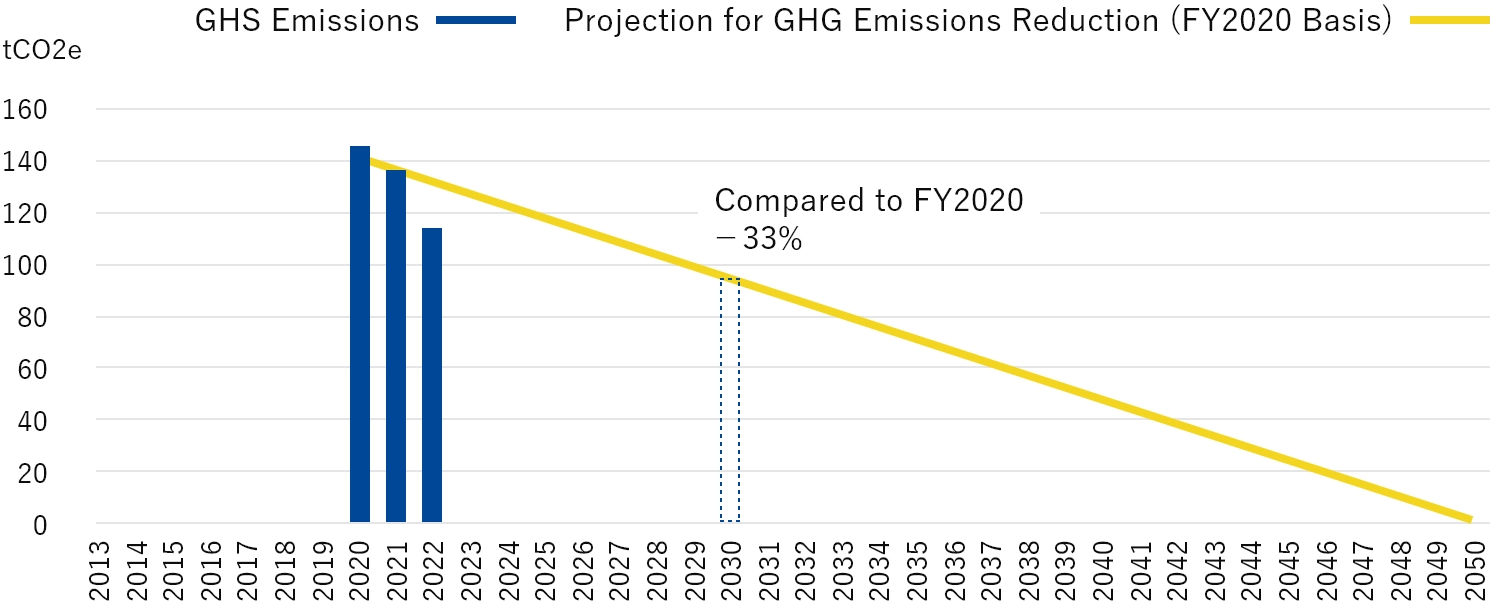
Initiatives for TCFD Recommendations on Responsible Investment
Asset management companies within SPARX Group analyze its responses to climate change and assess its impact through the management of portfolio companies are described as follows.
Governance
The Group upholds its purpose of "to make the world wealthier, healthier, and happier (through investment)." We identify and manage apparent and latent risks and opportunities related to all client assets to realize this purpose. Furthermore, we have established a separate Responsible Investment Committee, chaired by the Group CIO, as an advisory body to our Board of Directors in order to fulfill our responsibility for oversight and accountability for responsible investment.
The Responsible Investment Committee, which includes all full-time directors and Group executive officers, meets at least once a quarter and promptly reports its findings to the Board of Directors. In addition, we have established Responsible Investment Promotion department to promote concrete discussions on the implementation of PRI (Principles for Responsible Investment) in the Responsible Investment Committee.
The Committee hears reports from the Group companies' investment policy committees (and equivalent organizations) on their responsible investment practices, approves changes to the Responsible Investment Policy and other policies, and endorses annual reports on responsible investing. Responsible Investment Committee meetings are attended by external advisors who provide independent advice on the reports and deliberations while sharing their thoughts on the latest trends in responsible investing.
- Please refer to figure 1 for Corporate Governance Framework
Strategy
To resolve climate change, we must encourage portfolio companies to incorporate and address climate change-related risks and opportunities in their medium- to long-term business strategies. As an asset manager, we have asked S&P Global to conduct scenario analysis of the portfolios of listed equity investment strategy as well as listed alternative equities investment strategy*1, which account for most of our assets under management as of December 31, 2022. The analysis aims to uncover the impact of climate change-related risks and opportunities on our clients' asset portfolios.
The Group's AUM by Investment Strategy as of December-end 2022 are as follows:
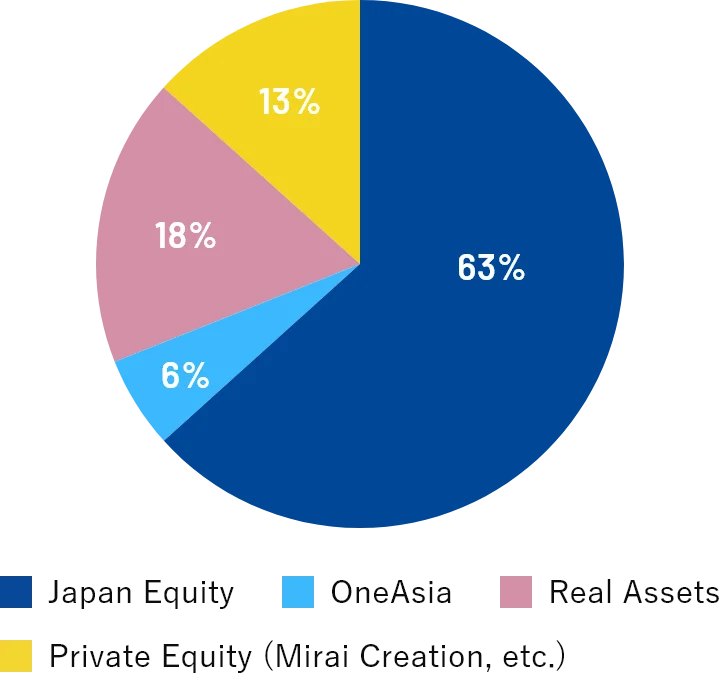
| Japanese Equity | 9,334 |
|---|---|
| OneAsia | 834 |
| Real Assets | 2,629 |
| Private Equity*2 (Mirai Creation, etc.) |
1,955 |
| Total | 14,754 |
Compliance with well below 2℃ target: Evaluating transitions away from greenhouse gases
We evaluated the portfolios and benchmarks of our Listed Equity and Alternative Equity Investment Strategies*3 for their compliance with international targets for combating global warming based on a transitionary approach. We used S&P Global's assessment on pathways to net-zero emissions to determine how well our portfolios aligned with the Paris Agreement target of well below 2℃.
In this evaluation, we look at past performance and future (medium-term) forecasted emissions to verify whether our portfolio companies' emission reductions over time are at an appropriate level in line with the global warming prevention targets. We concluded that the portfolios of our Listed Equity and Alternative Equity Investment Strategies fell between 2℃ and 3℃, while their benchmarks were above 3℃*4. Going forward, we will internally examine how we can align our portfolios to a level under 2℃.
- *1 【Listed equity investment strategy and listed alternative equities investment strategy】 are the sum of "Japanese Equity" and "OneAsia" shown above.
- *2 Our Private Equity Investment Strategy (Mirai Creation Funds) represents JPY153.1B of the Private Equity shown in the table.
- *3 The Listed Equity and Alternative Equity Investment Strategy benchmarks are a composite of TOPIX, KOSPI, and MSCI Asia ex Japan indices, weighted by the assets under management in the corresponding markets.
- *4 In last year's analysis, our portfolios were under 1.75℃, but the data we had covered only about 25% of the portfolios and 56% of the benchmarks, meaning we could not evaluate all of our holdings. However, this year, our data improved to show approximately 95% of our portfolios and 100% of our benchmarks, providing a clearer picture of our entire portfolios.

Transition Risks
The TCFD classifies climate-related risks into two categories: transition risks and physical risks. Transition risks are related to the move toward a carbon-free economy, while physical risks are related to the physical impact of climate change.
We assessed the financial impact of climate-related risks (e.g., the economic impact of future carbon prices) on our Listed Equity and Alternative Equity Investment Strategy portfolios.
The majority of the estimated future unpriced cost of carbon (UCC) in the portfolios of the Listed Equity and Alternative Equity Investment Strategies is in the materials sector, and the majority of this UCC by region is in South Korea. Therefore, these strategies' portfolios will likely see the most significant impact from the risk of climate-related policy changes that result in higher carbon costs in South Korea. The EBITDA-at-risk, representing the current ability of portfolio companies to pay for their future UCC, was approximately 19.85% of the portfolio weighted average in 2030 based on the high-risk scenario*5, while the benchmark was about 7.72%.
- *5 The scenario with the temperature rise limited to well below 2℃ by 2100 is consistent with the Paris Agreement and is based on OECD and IEA studies.
| 2021 | 2022 | |||
|---|---|---|---|---|
| Portfolio | Benchmark | Portfolio | Benchmark | |
| EBITDA at Risk | 8.99% | 8.48% | 19.85% | 7.72% |
Total Appotioned UCC by Sector
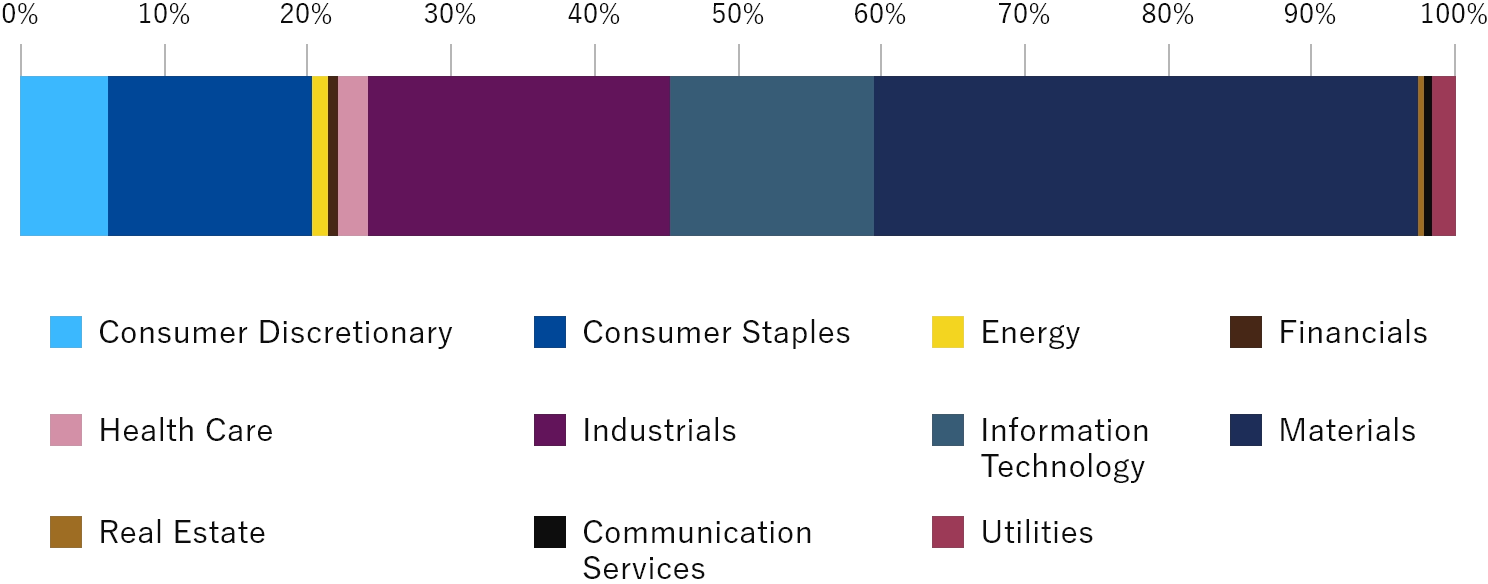
Total Appotioned UCC by Country

Physical Risks
We assessed the physical risks for our Listed Equity and Alternative Equity Investment Strategy portfolios based on moderate-to-high-risk scenarios for 2050*6. Of the eight hazard types (wildfires, cold waves, heat waves, water stress, coastal floods, fluvial floods, tropical cyclones, and droughts), cold waves and fluvial floods had the highest exposure scores, while heat waves had the highest financial impact.
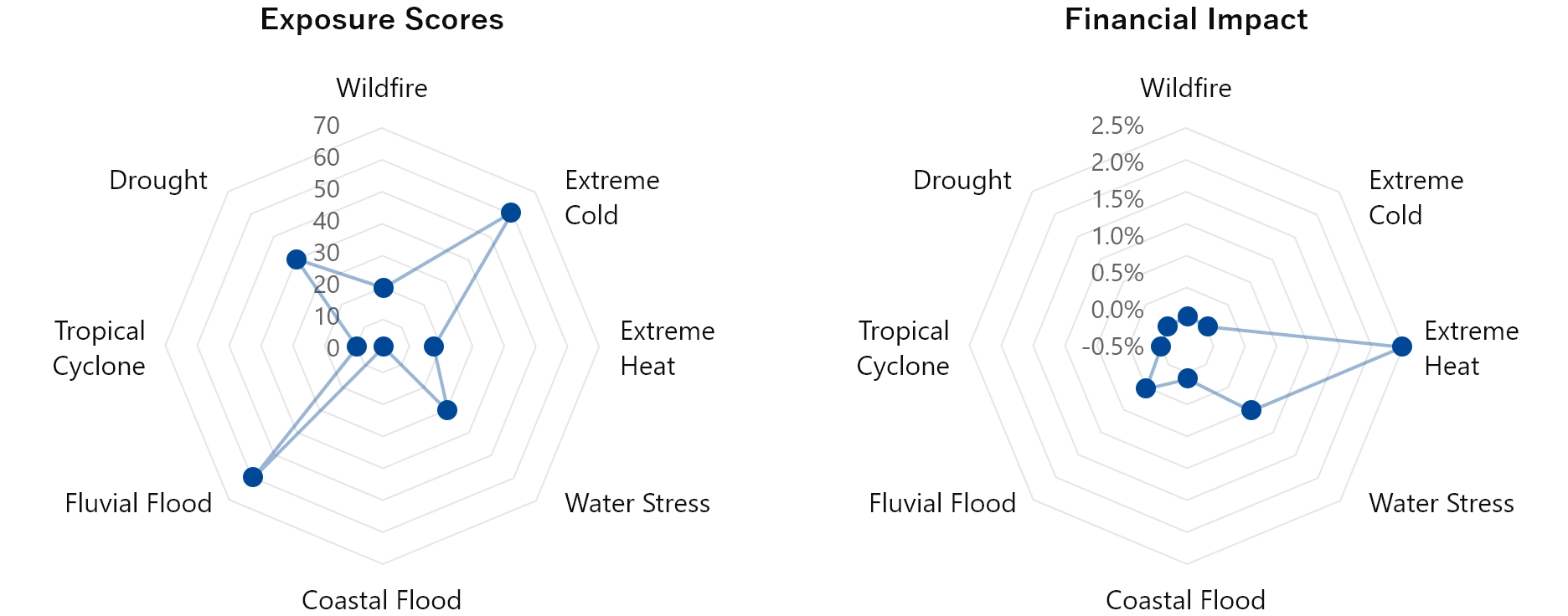
Source: Prepared by SPARX based on the S&P Global Data
- *6 The scenario with a temperature increase of 2.8-4.6℃ by 2100 corresponds to a Shared Socioeconomic Pathway (SSP) score of 3 and a Representative Concentration Pathway (RCP) score of 7.0. Exposure scores are expressed on a scale of 1 to 100, where 100 represents the maximum possible risk, and 1 is the minimum possible risk. The financial impact is expressed as a percentage (%) of the asset value of possible losses (e.g., capital expenditures, operating expenses, business interruption) that may occur due to climate change.
Risk Management
In researching and analyzing portfolio companies and making investment decisions, the Group emphasizes the qualitative evaluation of companies through bottom-up research. This bottom-up approach means we qualitatively evaluate ESG-related opportunities and risks along with our expected investment return estimates.
Moreover, the Group is working to develop a framework that enables it to encourage portfolio companies to promote climate change-related initiatives, while utilizing climate change-related data from outside vendors in selecting and speaking with engagement partners.
We reference climate change-related data from external vendors for the Listed Equity and Alternative Equity Investment Strategy portfolios. For each portfolio and benchmark (or reference index), we measure the carbon footprint (the CO2 equivalent of greenhouse gas emissions resulting from business activities) and weighted average carbon intensity (WACI). We then report these figures and our engagement numbers to the Responsible Investment Committee every quarter.*7
- *7 We began reporting our engagement numbers to the Responsible Investment Committee in January 2023.
Metrics and Targets
As an investment company and a corporation, SPARX Group supports the long-term goals of the Paris Agreement and is committed to taking proactive steps to limit the rise in average global temperatures. We aim for all our portfolio companies and projects to become net neutral in greenhouse gas emissions by 2050.
Below are our calculations for the TCFD's recommended disclosure requirements of carbon footprint (the equivalent CO2 resulting from business activities) and weighted average carbon intensity (WACI) for our Listed Equity and Alternative Equity Investment Strategy portfolios as of December 31, 2022.
Listed Equity Investment Strategy and Listed Alternative Equities Investment Strategy portfolios
| 2021 | 2022 | |
|---|---|---|
| Carbon Footprint | 1,201,434 tCO2e | 830,940 tCO2e |
| WACI | 167 tCO2e/million USD | 104 tCO2e/million USD |
For both the carbon footprint and WACI calculations above, we used S&P Global's data to calculate GHG emissions based on portfolio company disclosures or a proprietary approach using modeling in the absence of available information. We calculate Scope 1 and Scope 2 emissions with this approach. Our policy for the Group's assets under management is to actively utilize GHG emission ratings and external evaluation organization assessments to supplement our analytics. However, due to differences in data reliability and evaluation methods, we do not compare figures, instead preferring to continuously monitor data and consider their future use options.
Targets by individual strategy among managed client assets
The Listed Equity Investment Strategy and Listed Alternative Equities Investment Strategy
These investment strategies reflect our support for the long-term goals of the Paris Agreement and our commitment to taking proactive steps to limit the rise in average global temperatures. Therefore, we aim to have all our portfolio companies become net neutral in greenhouse gas emissions by 2050.
To achieve this goal, we believe it ideal for our portfolio companies to formulate and implement greenhouse gas reduction plans that comply with the Paris Agreement.
However, as part of this process, we must support companies likely to implement future reductions rather than investing only in companies with low emissions or reducing their carbon output per the Paris Agreement.
Thus, our immediate goal is that by 2025, at least 50% of our portfolios in all Japanese Equity funds*8 should be companies that have expressed support for the TCFD and are implementing emission reduction plans. We intend to encourage as many companies as possible to support us in these efforts. Future targets and results are as follows.
- *8 The strategy of investing in Japanese equities within the Listed Equity and Alternative Equity Investment Strategies
| Goal | Performance | |
|---|---|---|
| 2022 (Interim target) | TCFD supporter rate of 30% or more for all funds in the Japanese Equity Investment Strategy | 97% of funds (based on the number of funds) with a TCFD endorsement rate of 30% or higher |
| 2025 | TCFD supporter rate of 50% or more for all funds in the Japanese Equity Investment Strategy | - |
Private Equity Investment Strategy (Mirai Creation Funds)
These investment strategies reflect our support for the long-term goals of the Paris Agreement and our commitment to taking proactive steps to limit the rise in average global temperatures. We aim for all our portfolio companies and projects to become net neutral in greenhouse gas emissions by 2050. In the process, the managers of these investment strategies will guide our portfolio companies toward endorsing the TCFD. As guides, our managers participate in discussions on assessing climate-related risks and opportunities and their financial implications. These discussions maximize portfolio company commitment to financial disclosure on climate change before issuing their IPOs.
<Column>
Through long-term engagement, SPARX supports its portfolio companies in formulating and implementing greenhouse gas reduction plans that comply with the Paris Agreement. The following is a leading example of our engagement in 2022.
We met with the top management of a company with high GHG emissions and low ESG scores based on data from an ESG data vendor. We suggested that the company could enhance its reputation by proactively disclosing information on activities that positively affect the environment, including biomass power generation projects and forest investments. The company also recognized that its CO2 reduction efforts were not reflected in its valuation, and we received a favorable response about offering easy-to-understand disclosure in the future. The company's presentation materials now disclose detailed information on the CO2 sequestration effects of its forest holdings, and the company said it would reveal GHG Scopes 1 and 2 in the current fiscal year. We will continue monitoring its progress through ongoing engagement.